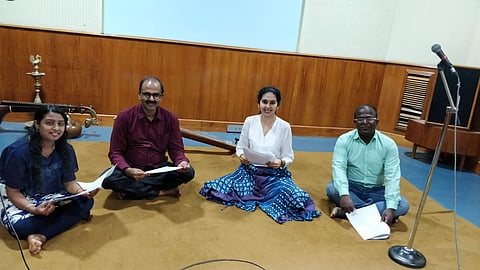

Who doesn't wait for 'Sunday Funday'? It's the perfect day to either sleep in, Netflix and chill or go out with friends and family. Akash and Bhoomi too make the most of every Sunday. Doing what, you wonder? Tune into the radio every Sunday at 8.35 am, setting the frequency at 612 KHz to find out. For a decade now, at this frequency, Prasar Bharati, Vigyan Prasar and the Department of Science and Technology, Government of India, have together been producing programmes to educate people on various issues and topics related to Science and Technology. So who are Akash and Bhoomi? They are characters in a programme called Bhoorameya Bisiyusiru. While Akash is a research scholar in Physics, Bhoomi is interested in research in History and Religion. And this year, they come together to educate people on climate change and global warming. Apart from these two characters, Sumangala S Mummigatti, who is the programme executive, accompanies the audience through each episode.
Pick a topic
Considering the relevance of today's situation, the choice of content for the programme this year seems appropriate, believes Sumangala, "This is not the first time we are airing a programme related to Science. Prior to this, we have produced programmes related to Earth, women and Science, Mathematics, Physics etc. This year, a group of scientists from Vigyan Prasar decided to run a programme on climate change. I think the subject is relevant in light of the current situation where there is a sudden and extreme increase in temperature, uneven distribution of rain, delayed rains, improper food chain, endangerment of species and much more. These Science programmes are broadcast for two reasons — to create awareness among people about the development and applications of technology in our daily life and to bring a change among people to save resources.
And not just by teaching Science, they also reach the masses by airing the programme in 19 languages across India. Sumangala says, "There is a committee for this programme who decides the topics and the content. It includes 19 producers, a nodal officer and a few experts. We meet either in November or December to decide the topics for 52 episodes. Though we speak about the same topic across India, the format changes. Some are completely in the drama format and some are in the docudrama format." This year, the programme has completed six episodes.
While global warming, the reasons for it and solutions was the topic of the first episode, the second episode dealt with weather and climate. Sumangala says, "Usually, people think both these words convey the same meaning. While weather is the day-to-day temperature in a city or country, climate is the weather in a city or country over an average period of 30 to 50 years. And we don't just tell them the meaning of global warming, we give them present-day examples to show its impact on food production, health, fisheries, volcanoes and oceans. By the end of the 52nd episode, everyone would have understood the entire concept. The topics can be easily understood by anybody," Sumangala states another example. While the world is talking at length about the Greenhouse Effect, not everyone knows what it means. To explain it in simple terms, Sumangala gives the example of a car parked under the sun for a few hours and how it becomes hot inside. This is because the glass traps the heat inside. But just because she simplifies concepts, it doesn't mean that she avoids discussing important topics like the Kyoto Protocol and other policies framed to reduce global warming.
Truth be told
Sumangala takes extra care to keep the listeners hooked to the radio station. One such way is by producing different sounds related to water, air and fire. Even Kannada songs related to nature are included. In fact, Sumangala herself pens the lyrics for these songs. The characters, Bhoomi and Akash, travel across India and meet different people including farmers, scientists and weather experts. She says, "Since they are research scholars, they travel across the country. For example, they visit the Western Ghats looking for a particular tree called Holegeru. Unfortunately, there are only 14 trees left in the forest. The reason? A moth called the Malabar Nymph, which is responsible for pollination, has become extinct. Due to climate change, the flowering stage in these trees has become delayed, leading to the species' extinction, which in turn has led to the reduction of trees. This is a true story but how many people know it?"
At the end of every episode, the listeners are asked two questions and they can send their answers either through WhatsApp, email or letters. Listeners also write letters about trees and animals that they've seen during their childhood that are now endangered or extinct. Such letters are used as material for content. People have brought changes in their lifestyles after listening to these true stories as well. "There should be participation from people when it comes to solving environment-related
Content is king
So who writes the script for these topics? Usually, it is written by teachers or professors who are come from Science background. Workshops are conducted to train them in writing scripts according to the format. Sumangala goes through the scripts and edits them along with the opinion of experts. Every eighth episode is a recap and an interactive one where people can clear their doubts. And a minimum of three scripts and three recordings are banked before they air the show.
Here are the stations in Karnataka where people can access the show
Bengaluru 612 KHz or 490.1 Meter Mw
Mysuru: FM 100.6 MHz
Bhadravathi: Mw 675KHz/ FM 103.5 MHz
Dharwad: Mw 765 KHz
Kalaburgi: Mw 1107 KHz
19 languages in which the show goes live
Gujarati, Kannada, Telugu, Tamil, Malayalam, Odia, English, Hindi, Konkani, Punjabi, Marathi, Nagamese, Manipuri, Kashmiri, Nepali, Assamese, Mizo, Bengali and Khasi are those 19 beautiful languages.
